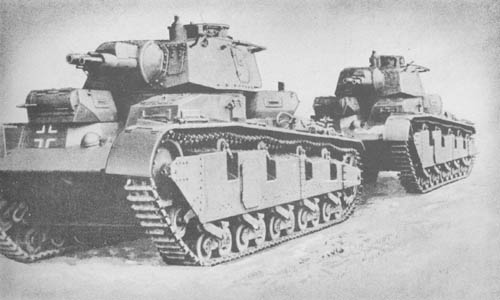
Although this tank represents a great deal of Germany’s early experimental development, it is reported that only three were produced (1937), and that two were seen in Norway (1941) where they were destroyed, while the third was destroyed by the Russians near the Rumanian border.
The Pz. Kpfw. V, weighing 36 tons equipped for action, was manned by a crew of seven—commander, driver, main gunner, loader, wireless operator/machine gunner, and two auxiliary turret machine gunners. In addition to the main turret which mounted a 7.5 cm Kw. K. and coaxial 3.7 cm gun and machine gun, there were two additional revolving machine-gun turrets fitted in the front right and rear left of the hull, each fitted with a 7.9 mm machine gun.
Its suspension consisted of ten small bogie wheels mounted in articulating pairs, and four return rollers. Between the high front idler and first bogie assembly an additional independent roller resisted the track. The driving sprocket, unlike usual German procedure, is mounted in the rear, as is the engine, a V-12 HL 120 TRM, and the transmission and differential assemblies.
The sloping turret and the circular superstructure employed considerable riveted as well as welded construction. The commander’s cupola, fitted with periscope, was situated at the rear of the turret. Access doors were located on each side of the turret. Riveted armor skirting was fitted along the length of the tank between bogie wheels and return rollers. Two access doors were located in the forward portion of the skirting on the right side and one on the left.
This was considered a heavily armed vehicle, but it in no way represented German design technique for that period but rather that of several years previous.
German: p. 36